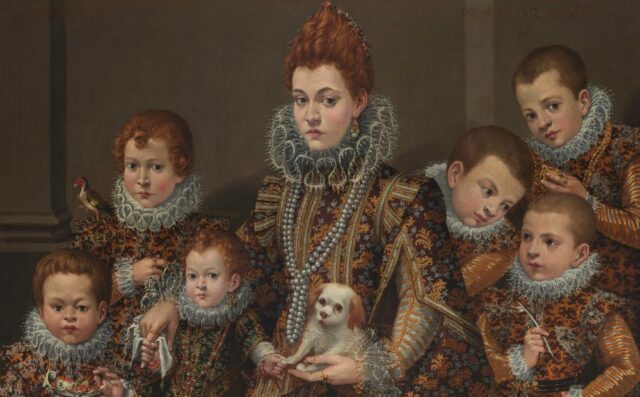Lavinia Fontana was one of the most compelling portraitists of her time. As a painter, she was known for her exquisite descriptions of costumes and jewelry and her expressive portrayals of women and children. The Fine Arts Museum of San Francisco has announced the acquisition of Portrait of Bianca delgi Utili Maselli and her Children — a rare and significant portrait by Fontana. On public view for the first time in over 400 years, it is also the first work of art created by a woman before 1700 to join the collection housed at the Legion of Honor. This is more than the story of an acquisition. Portrait of Bianca delgi Utili Maselli and her Children is a story of two women, painter and sitter, and where their extraordinary lives intersected.
The Florentine Mannerist Tradition
Mannerism comes from the Italian maniera, meaning “style.” Portrait of Bianca delgi Utili Maselli and her Children has the earmarks of the High Renaissance era including the stylized elegance of patterned fabric and an emphasis on slightly exaggerated bodies and facial features. Lavinia Fontana was born in Bologna, Italy and trained by her father who was a former studio assistant to the Florentine Mannerist Giorgio Vasari. Fontana’s rise as a painter coincided with a time in Bologna when women had greater opportunities to participate in public life. Such women became Fontana’s core clientele, and the artist’s attention to detail in her rendering of glittering jewelry and sumptuous textiles earned her stylish patronage. As a mother to eleven children, of whom only three would survive her, Fontana painted juvenile subjects with a particular tenderness and sensitivity.
A Story of Family and Grief
“Portrait of Bianca delgi Utili Maselli and her Children is an unusually spectacular work – winsome in subject, grand in scale, richly painted, and beautifully preserved,” observed Emily Beeny, Chief Curator of the Legion of Honor and Barbara A. Wolfe Curator-in-Charge of European Paintings. “It opens a window onto the life of a Roman noblewoman and her family, marked by both privilege and grief.”
Bianca delgi Utili Maselli (1568-1605) bore 19 children before dying from complications of childbirth at the age of 37. Appearing with five sons and a daughter, Bianca delgi Utili Maselli’s index finger is grasped by her infant daughter, her other hand holding a tiny dog. The children echo the large expressive eyes and red hair of the mother while the positing of their heads, hands and eyes communicate the restless fidgeting of children. Gold and crimson textiles shimmer next to pearls and diamonds, and each sitter holds one accessory: the aforementioned dog; a quill pen and ink well; a songbird on a leash; a silver cup of figs; and a gold medallion.
The inscription along the top edge identifies the family yet the only sitter identified by her own inscription is Maselli’s young daughter “Verginia.” Verginia Maselli survived into adulthood and married Fausto Bartoli in 1620, to whom she bore three children. One was a daughter, Maria Felice, who married into the Marchetti family. The unusually fine condition of the painting is attributed to the unbroken line of inheritance as the work descended through the Marchettis for nearly four centuries.

(Photograph by Steve Whittaker, ©FAMSF. Image courtesy of the Fine Arts Museums of San Francisco)
Lavinia Fontana’s Career
As one of the leading artists of her age, Lavinia Fontana was the recipient of major public commissions for altarpieces in her native Bologna, Rome, and as far away as Madrid. Born in 1552 and trained with her father Prospero, a minor Mannerist, she had already embarked on a promising career in portraiture by 1577 when she married Gian Paolo Zappi, an occasional studio assistant to her father. Unusual for the time, her marriage stipulated that Fontana would continue to practice her profession unhindered by housekeeping duties. Even though she had many children, she would take on commissions of increasing importance while Zappi gave up his own career to serve as her agent and help manage her thriving studio.
The Acquisition
The acquisition of Portrait of Bianca delgi Utili Maselli and her Children was made possible by support from Margaret and William R. Hears III, the Lisa and Douglas Goldman Fund, John A. and Cynthia Fry Gunn, Dagmar Dolby and the Roscoe and Margaret Oakes Endowment Income fund in celebration of the Legion of Honor centennial. The painting was acquired through Ben Elwes Fine Art, London.
Sharon Anderson is an artist and writer in Southern California. She can be reached at mindtheimage.com.




